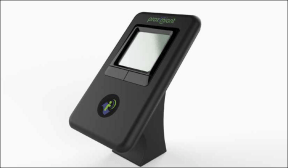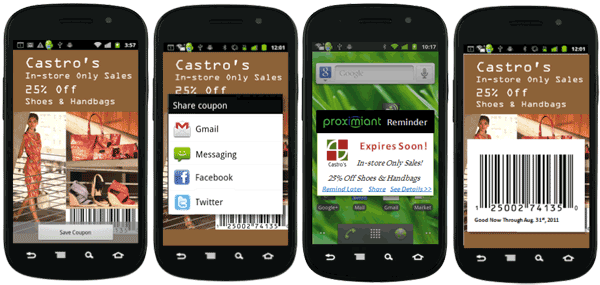
Proximiant just launched a new service that provides digital receipts to customers of brick-and-mortar merchants. Like Square, the service involves the use of a low-cost hardware dongle that’s given away for free. But unlike Square, Proximiant leverages NFC (near field communication) to send the receipt from the cash register to the mobile phone.
NFC is a newer technology that ships in many modern mobile phones allowing for data exchanges over short distances. In Android 4.0, for example, NFC has been re-branded “Android Beam,” allowing users to share contacts, links, maps and more through a simple tap.
In Proximiant’s case, the service uses NFC to send out digital copies of a store’s receipts to a customer’s phone, also with a tap. For non-NFC devices, like the iPhone, an NFC tag (a keychain tag) is provided instead. Merchants give these tags away for free to customers who then pair them with their own mobile phone.
The Proximiant transceiver, a phone-sized device that plugs into a store’s computerized cash register via the USB port, will sit at the merchant’s checkout counter. The setup process take two minutes, the company claims. However, the device doesn’t integrate with POS systems. That’s by design, says Proximiant – it’s meant to support any software the merchant is using. Instead, the transceiver grabs the receipt data from the PC when a receipt is printed and sends it over a secure connection to the customer’s phone (upon tapping) as a digital image. A scannable barcode on the receipt allows the merchant to scan the phone itself in the event of a customer return or refund request, and the accompanying mobile app on the customer’s phone provides an archive of their transactions.
For merchants, adoption is relatively painless. There’s no upfront service cost, the system is plug-and-play and the hardware is free. However, merchants are charged on a pay-by-sales model for results Proximiant achieves. The retailers can choose to leverage the system to market to their customers via the digital receipts. (Yep, no good mobile commerce app would be any good these days without offers, right?)

Proximiant supports various marketing efforts, promotions, referral programs and loyalty programs, without requiring customers to hand over personal info like their email address or phone number. Merchants manage the programs via an online interface. Meanwhile, customers can save coupons phones within the Proximiant mobile app (Android/iPhone), redeem coupons at checkout by showing a barcode, share the coupons via email, SMS and social networks, configure reminders based on time or location, and access their receipts via the Web or phone.
The company is led by Fang Cheng (CEO), who previously co-founded Touchco, Inc., which was later acquired by a Fortune 100 company. Edwin Evans, who serves as VP of Engineering, co-found Quinly, a mobile app development shop, and worked on Motorola’s Android project and at Good Technology. Thomas Ahn previously worked for a network and data compression software startup, ViaSat. Rich Geruson, CEO of Phoenix Technologies and former SVP at Nokia, and Chung-Man Tam, now the entrepreneur-in-residence at Sequoia and formerly with Google, are serving as advisors.
Proximiant is certainly an interesting idea – from a consumer’s standpoint, I’d love to have digital receipts without having to snap photos of them with apps like Lemon, Expensify, Shoeboxed, and others or provide inbox access as with Slice and OneReceipt. However, Proximiant’s real competition doesn’t come from other receipt organizers – it comes from services like Square, which is already well on its way to building a viable m-commerce platform without having to workaround the fact that not all phones have NFC. Having to use a keychain tag, as all iPhone users will need to do with Proximiant (unless Apple decides to join the NFC bandwagon with the iPhone 5), isn’t as simple as tapping your phone. Keychain tags fall off, keys get buried in purses and bags, and frankly, some people just hate the keychain clutter they cause. Meanwhile, a phone is almost always in a pocket or hand, easily accessible.
Proximiant is fully self-funded and is currently running beta trials in a dozen stores in the San Francisco Bay area and Palo Alto.
Source:http://techcrunch.com/2011/11/30/proximiant-launches-tap-and-go-digital-receipts-for-retailers/
NFC is a newer technology that ships in many modern mobile phones allowing for data exchanges over short distances. In Android 4.0, for example, NFC has been re-branded “Android Beam,” allowing users to share contacts, links, maps and more through a simple tap.
In Proximiant’s case, the service uses NFC to send out digital copies of a store’s receipts to a customer’s phone, also with a tap. For non-NFC devices, like the iPhone, an NFC tag (a keychain tag) is provided instead. Merchants give these tags away for free to customers who then pair them with their own mobile phone.
The Proximiant transceiver, a phone-sized device that plugs into a store’s computerized cash register via the USB port, will sit at the merchant’s checkout counter. The setup process take two minutes, the company claims. However, the device doesn’t integrate with POS systems. That’s by design, says Proximiant – it’s meant to support any software the merchant is using. Instead, the transceiver grabs the receipt data from the PC when a receipt is printed and sends it over a secure connection to the customer’s phone (upon tapping) as a digital image. A scannable barcode on the receipt allows the merchant to scan the phone itself in the event of a customer return or refund request, and the accompanying mobile app on the customer’s phone provides an archive of their transactions.
For merchants, adoption is relatively painless. There’s no upfront service cost, the system is plug-and-play and the hardware is free. However, merchants are charged on a pay-by-sales model for results Proximiant achieves. The retailers can choose to leverage the system to market to their customers via the digital receipts. (Yep, no good mobile commerce app would be any good these days without offers, right?)

Proximiant supports various marketing efforts, promotions, referral programs and loyalty programs, without requiring customers to hand over personal info like their email address or phone number. Merchants manage the programs via an online interface. Meanwhile, customers can save coupons phones within the Proximiant mobile app (Android/iPhone), redeem coupons at checkout by showing a barcode, share the coupons via email, SMS and social networks, configure reminders based on time or location, and access their receipts via the Web or phone.
The company is led by Fang Cheng (CEO), who previously co-founded Touchco, Inc., which was later acquired by a Fortune 100 company. Edwin Evans, who serves as VP of Engineering, co-found Quinly, a mobile app development shop, and worked on Motorola’s Android project and at Good Technology. Thomas Ahn previously worked for a network and data compression software startup, ViaSat. Rich Geruson, CEO of Phoenix Technologies and former SVP at Nokia, and Chung-Man Tam, now the entrepreneur-in-residence at Sequoia and formerly with Google, are serving as advisors.
Proximiant is certainly an interesting idea – from a consumer’s standpoint, I’d love to have digital receipts without having to snap photos of them with apps like Lemon, Expensify, Shoeboxed, and others or provide inbox access as with Slice and OneReceipt. However, Proximiant’s real competition doesn’t come from other receipt organizers – it comes from services like Square, which is already well on its way to building a viable m-commerce platform without having to workaround the fact that not all phones have NFC. Having to use a keychain tag, as all iPhone users will need to do with Proximiant (unless Apple decides to join the NFC bandwagon with the iPhone 5), isn’t as simple as tapping your phone. Keychain tags fall off, keys get buried in purses and bags, and frankly, some people just hate the keychain clutter they cause. Meanwhile, a phone is almost always in a pocket or hand, easily accessible.
Proximiant is fully self-funded and is currently running beta trials in a dozen stores in the San Francisco Bay area and Palo Alto.
Source:http://techcrunch.com/2011/11/30/proximiant-launches-tap-and-go-digital-receipts-for-retailers/

No comments:
Post a Comment